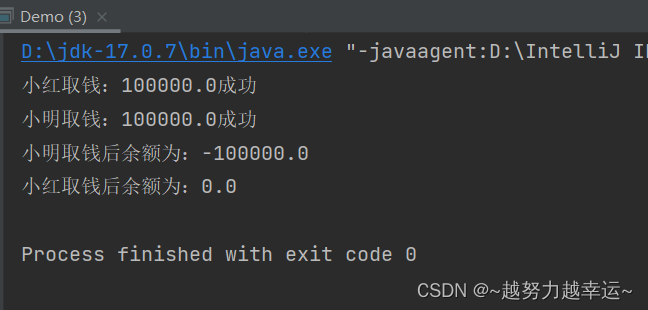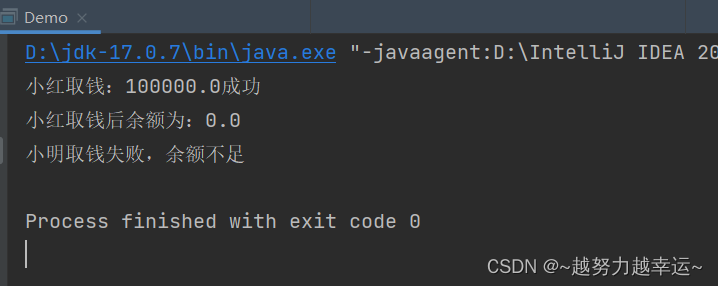-
【多线程】线程安全与线程同步
线程安全与线程同步
1.什么是线程安全问题?
多个线程同时操作同一个共享资源的时候,可能会出现业务安全问题
取钱的线程安全问题场景:
两个人他们有一个共同的账户,余额是10万元,如果两个人同时来取钱,并且2人各自都在取钱10万元,可能会出现什么问题?
(1)线程安全问题出现的原因:- 存在多个线程在同时执行
- 同时访问一个共享资源
- 存在修改该共享资源

2.线程同步
线程同步就是解决线程安全问题的方案
(1)线程同步的思想:让多个线程实现先后依次访问共享资源,这样就解决了安全问题
(2)线程同步的常见方案
- 加锁:每次只允许一个线程加锁,加锁后才能进入访问,访问完毕后自动解锁,然后其他线程才能再加锁进来
(3)线程同步方式
-
方式一:同步代码块
①作用:把访问共享资源的核心代码给上锁,以此保证线程的安全
②原理:每次只允许一个线程加锁后进入,执行完毕后自动解锁,其他线程才可以进来执行
③同步锁的注意事项:对于当前同时执行的线程来说,同步锁必须是同一把(同一个对象),否则会出bug
④锁对象不能随便选择一个唯一的对象,会影响其他无关线程的执行,例如String字符串
⑤锁对象的使用规范
- 建议使用共享资源作为锁对象,对于实例方法建议使用this作为锁对象
- 对于静态方法建议使用字节码(类名.class)对象作为锁对象
public class Demo { public static void main(String[] args) { //3、创建账户对象(共享数据) Account acc = new Account("9527", 100000); //4、两个线程同时取款(多个线程操作共享数据,出现线程安全问题) new MyThread(acc, "小明").start(); new MyThread(acc, "小红").start(); } } //2、线程类,封装取款的代码 class MyThread extends Thread { private Account acc; public MyThread(Account acc, String name) { super(name); this.acc = acc; } @Override public void run() { //取钱时,要传递取款金额 acc.drawMoney(100000); } } //1、账户类,包含取款功能 class Account { //卡号 private String cardID; //余额 private double money; public Account() { } public Account(String cardID, double money) { this.cardID = cardID; this.money = money; } public String getCardID() { return cardID; } public void setCardID(String cardID) { this.cardID = cardID; } public double getMoney() { return money; } public void setMoney(double money) { this.money = money; } //取款功能,参数money为取款金额 public void drawMoney(double money) { //获取当前线程对象的名称 String name = Thread.currentThread().getName(); synchronized (this) { if (this.money >= money) { System.out.println(name + "取钱:" + money + "成功"); this.money -= money; System.out.println(name + "取钱后余额为:" + this.money); } else { System.out.println(name + "取钱失败,余额不足"); } } } //对于静态方法建议使用字节码(类名.class)对象作为锁对象 public static void test(){ synchronized (Account.class){ } } }- 1
- 2
- 3
- 4
- 5
- 6
- 7
- 8
- 9
- 10
- 11
- 12
- 13
- 14
- 15
- 16
- 17
- 18
- 19
- 20
- 21
- 22
- 23
- 24
- 25
- 26
- 27
- 28
- 29
- 30
- 31
- 32
- 33
- 34
- 35
- 36
- 37
- 38
- 39
- 40
- 41
- 42
- 43
- 44
- 45
- 46
- 47
- 48
- 49
- 50
- 51
- 52
- 53
- 54
- 55
- 56
- 57
- 58
- 59
- 60
- 61
- 62
- 63
- 64
- 65
- 66
- 67
- 68
- 69
- 70
- 71
- 72
- 73
- 74
- 75
- 76

-
方式二:同步方法
①作用:把访问共享资源的核心方法上锁,以此保证线程安全
②原理:每次只允许一个线程加锁后进入,执行完毕后自动解锁,其他线程才可以进来执行
③同步方法的底层原理
- 同步方法其实底层也是由隐式锁对象的,只是锁的范围是整个方法代码
- 如果方法是实例方法:同步方法默认this作为锁的对象
- 如果方法是静态方法:同步方法默认用类名.class作为锁对象
//线程类和测试类同上 //1、账户类,包含取款功能 class Account { //卡号 private String cardID; //余额 private double money; public Account() { } public Account(String cardID, double money) { this.cardID = cardID; this.money = money; } public String getCardID() { return cardID; } public void setCardID(String cardID) { this.cardID = cardID; } public double getMoney() { return money; } public void setMoney(double money) { this.money = money; } //取款功能,参数money为取款金额 public synchronized void drawMoney(double money) { String name = Thread.currentThread().getName(); if (this.money >= money) { System.out.println(name + "取钱:" + money + "成功"); this.money -= money; System.out.println(name + "取钱后余额为:" + this.money); } else { System.out.println(name + "取钱失败,余额不足"); } } //静态方法 public synchronized static void test(){ } }- 1
- 2
- 3
- 4
- 5
- 6
- 7
- 8
- 9
- 10
- 11
- 12
- 13
- 14
- 15
- 16
- 17
- 18
- 19
- 20
- 21
- 22
- 23
- 24
- 25
- 26
- 27
- 28
- 29
- 30
- 31
- 32
- 33
- 34
- 35
- 36
- 37
- 38
- 39
- 40
- 41
- 42
- 43
- 44
- 45
- 46
- 47
- 48
④同步代码块和同步方法的区别
同步代码块:锁对象可以指定,锁的范围可以指定,性能高且灵活
同步方法:锁对象不能指定,锁的是方法体,阅读性更高
-
方式三:Lock锁
①Lock锁是JDK5开始提供的一个新的锁定操作,通过它可以创建出锁对象进行加锁和解锁,更灵活、更方便、更强大
②Lock是接口,不能直接被实例化,可以采用它的实现类ReentrantLock来构建Lock锁对象
public ReentrantLock():获得Lock锁的实现类对象
③Lock的常用方法
- void lock():获得锁
- void unlock():释放锁
④Lock锁使用规范
- 锁对象创建在成员位置,使用final修饰
- 释放锁的代码写在finally块中
public class Demo { public static void main(String[] args) { //3、创建账户对象(共享数据) Account acc = new Account("9527", 100000); //4、两个线程同时取款(多个线程操作共享数据,出现线程安全问题) new MyThread(acc, "小明").start(); new MyThread(acc, "小红").start(); } } //2、线程类,封装取款的代码 class MyThread extends Thread { private Account acc; public MyThread(Account acc, String name) { super(name); this.acc = acc; } @Override public void run() { //取钱时,要传递取款金额 acc.drawMoney(100000); } } //1、账户类,包含取款功能 class Account { //卡号 private String cardID; //余额 private double money; //规范1、锁对象创建在成员位置,使用final修饰 private final ReentrantLock lock = new ReentrantLock(); public Account() { } public Account(String cardID, double money) { this.cardID = cardID; this.money = money; } public String getCardID() { return cardID; } public void setCardID(String cardID) { this.cardID = cardID; } public double getMoney() { return money; } public void setMoney(double money) { this.money = money; } //取款功能,参数money为取款金额 public void drawMoney(double money) { String name = Thread.currentThread().getName(); try { //上锁 lock.lock(); if (this.money >= money) { System.out.println(name + "取钱:" + money + "成功"); this.money -= money; System.out.println(name + "取钱后余额为:" + this.money); } else { System.out.println(name + "取钱失败,余额不足"); } } catch (Exception e) { e.printStackTrace(); } finally { //释放锁 lock.unlock(); } } }- 1
- 2
- 3
- 4
- 5
- 6
- 7
- 8
- 9
- 10
- 11
- 12
- 13
- 14
- 15
- 16
- 17
- 18
- 19
- 20
- 21
- 22
- 23
- 24
- 25
- 26
- 27
- 28
- 29
- 30
- 31
- 32
- 33
- 34
- 35
- 36
- 37
- 38
- 39
- 40
- 41
- 42
- 43
- 44
- 45
- 46
- 47
- 48
- 49
- 50
- 51
- 52
- 53
- 54
- 55
- 56
- 57
- 58
- 59
- 60
- 61
- 62
- 63
- 64
- 65
- 66
- 67
- 68
- 69
- 70
- 71
- 72
- 73
- 74
- 75
- 76
- 77
-
相关阅读:
我理解的游戏数据模型
WebDAV之葫芦儿•派盘+FolderSync
MSDC 4.3 接口规范(7)
碳中和专题:碳足迹核算、碳中和顶刊论文、碳排放交易2022
《C++ Primer》第2章 变量(二)
CDGA考试-2022年最新模拟题一套100道题(含答案)
竞赛题-6233. 温度转换
Appium和Android常用9种自动化测试框架对比有哪些优势?
LLM-Embedder
低能量电子束曝光技术
- 原文地址:https://blog.csdn.net/m0_65462447/article/details/132740383
